Do US super-carriers make sense any more? The BBC goes on board one
It looked small at first, in the vast expanse of the Pacific Ocean. Yet as we approached the USS Carl Vinson it filled the view out of the back of the Osprey tilt-rotor which was carrying us there, its deck packed with state-of-the-art warplanes. At nearly 90,000 tonnes, and more than 300 metres in length, the nuclear-powered Carl Vinson is one of the largest warships ever built.
Watching its FA18 and F35 fighter jets being hurled into the air every minute or two by the carrier's steam catapults is a spine-tingling experience, a procedure managed with impressive composure by the crew on the crowded deck.
An untimely Pacific squall which drenched us and everything else did not slow them at all.
Even after years of rapid advances in Chinese military capabilities, the United States is still unrivalled in its capacity to project force anywhere around the world with its fleet of 11 super-carriers.
But does a $13bn (£10bn) aircraft carrier which the latest Chinese missiles could sink in a matter of minutes make sense any more - particularly in the age of Donald Trump?
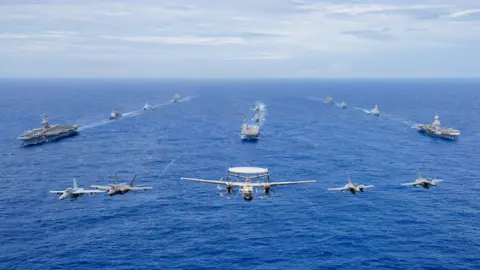 BBC/Natalie Thomas
BBC/Natalie ThomasWe had been invited onto the Carl Vinson to see another side of US carrier strategy, one which emphasises American friendliness, and willingness to work with allies – something you don't hear much in Washington these days.
The Carl Vinson was taking part in an exercise with two other aircraft carriers and their escorting destroyers from France and Japan, about 200km east of the Philippines. In the absence of wars to fight, US carrier groups spend much of their time doing this, learning how to operate together with allied navies. Last year they held one exercise that brought together ships from 18 navies.
This one was smaller, but was the first in the Pacific involving a French carrier for more than 40 years.
Making the case for alliances
Down in the massive hangar, below the noisy flight deck, Rear Adm Michael Wosje, commander of the Carl Vinson's strike force, was sitting with his French colleague, Rear Adm Jacques Mallard of the carrier Charles de Gaulle, and his Japanese colleague Rear Adm Natsui Takashi of the Kaga, which is in the process of being converted to Japan's first aircraft carrier since World War Two.
The Charles de Gaulle is the only warship in the world which matches some of the capabilities of the US super-carriers, but even then is only half their size.
All three admirals were brimming with bonhomie.
The fraught scenes in Europe, where President Trump's men were ripping up the rule book which underscored the international order for the past 80 years, and telling one-time allies they were now on their own, seemed a world away.
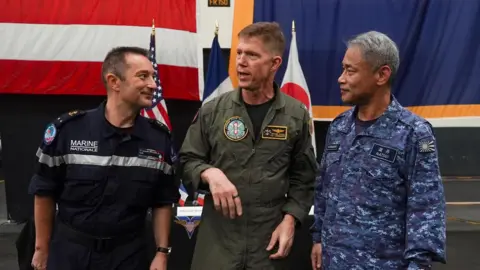 BBC/Natalie Thomas
BBC/Natalie Thomas"Our network of strong alliances and partnerships, such as those that we share with France and Japan, is a key advantage of our nations as we confront our collective security challenges," said Adm Wosje. In impeccable English Adm Mallard concurred: "This exercise is the expression of a will to better understand each other, and to work for the defence of compliance in international law."
No one mentioned the radical new views emanating from Washington, nor did they mention an increasingly assertive China, although Adm Natsui might have had both in mind when he said Japan now found itself in "the most severe and complex security environment. No country can now protect her own security alone."
Down in the warren of steel corridors which make up the living quarters of the 5,000 men and women on the Carl Vinson, the official portraits of the new president and vice-president were already hanging, the one of Trump with its now familiar pugilistic glower. We were not permitted to interview the crew, and politics would have been off-limits anyway, but some of those on board were curious what I thought of the new administration.
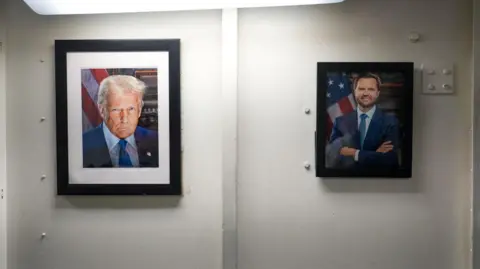 BBC/Natalie Thomas
BBC/Natalie ThomasInternet access on board is spotty, but they do keep in touch with home. We were told they even get Amazon deliveries while at sea, picked up from designated collection points.
It is a fair bet then that there is plenty of discussion of what President Trump has in store for these giants of the navy. Elon Musk has already vowed to bring his cost-cutting wrecking ball to the Pentagon and its $900bn budget, and Defence Secretary Pete Hegseth has welcomed that, although, he stressed, the Pentagon is not USAID which President Trump has vowed to shut down completely.
In the hangar we watched the crew maintaining the aircraft, surrounded by packing cases and spare parts. We were warned not to film any exposed parts of these technological marvels, for fear of revealing classified information. We could not even risk touching the F35 fighters, which have a prohibitively expensive special coating to help conceal them from radar.
They showed us the "Jet Shop" where they repair and test the engines, a technician who identified himself as '082 Madeiro' explained that they needed to carry enough spare parts to keep the planes flying on long deployments, and that after a certain number of hours the engines had to be completely replaced, whether or not they were faulty. There was a brand new engine in its enormous packaging next to him. Cost, around $15m.
Here to stay?
Running the Carl Vinson costs around $700m a year.
So will the Trump administration take a knife to the Pentagon budget? Hegseth has said he believes there are significant efficiencies to be found. He has also openly mused about the value of aircraft carriers. "If our whole power projection platform is aircraft carriers, and if 15 hypersonic missiles can take out our ten aircraft carriers in the first 20 minutes of conflict, what does that look like?", he said in an interview last November.
The debate about the utility of aircraft carriers is not new. It goes right back to when they first appeared a century ago. Critics today argue that they are too vulnerable to the latest generation of Chinese ballistic and hypersonic missiles, forcing them to stay at a distance from the Chinese coast which would put their aircraft out of range. The money, they say, would be better spent on newer technology.
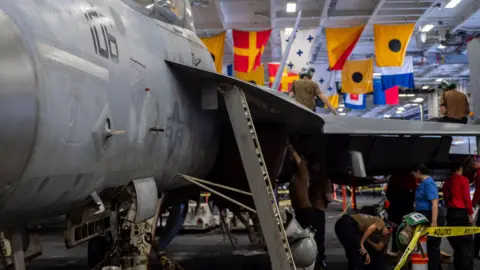 BBC/Natalie Thomas
BBC/Natalie Thomas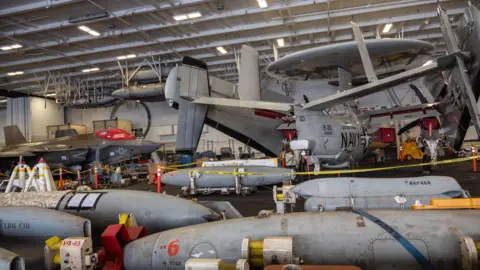 BBC/Natalie Thomas
BBC/Natalie ThomasThere is something archaic about these massive, welded hunks of steel, that seemed to have their heyday in the Pacific War of the 1940s. Yet in the vast expanse of the ocean, with few airfields, it has proved difficult to do without them. Supporters argue that, with their escorts of guided-missile destroyers, the super carriers can defend themselves quite well, and that they are still hard to sink. Downsize these carriers, to carry only helicopters or planes which can land and take off vertically as many countries have done, and you end up with vessels which are even more vulnerable.
It is worth noting that China too believes in the value of aircraft carriers; it has already built three. And as floating symbols of US prestige, they may appeal to President Trump, a man known for his love of flamboyant structures, whatever the economic arguments for and against them.
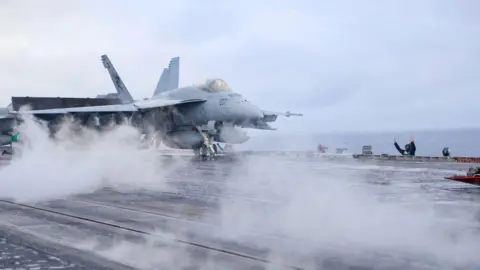 BBC/Natalie Thomas
BBC/Natalie ThomasAt his Senate confirmation hearing Pete Hegseth said the Trump administration would prioritise increased ship-building, although he did not say how this can be achieved. The US has only four naval shipyards left; China has, by some estimates, more than 200 times the ship-building capacity of the US. He also told his counterparts in Japan and South Korea that he wanted to deepen defence co-operation with them. Europe may be on its own, but it seems Asian allies will get the attention of this White House as it focuses on the strategic challenge posed by China.
Three new Ford-class nuclear carriers, the next generation after the Carl Vinson, are currently under construction, although two will not be in service until the next decade. The plan is to complete ten of this new class of carrier, and so far there have been no indications that the Trump administration wants to change that. For all its many critics, the US super-carrier is probably here to stay.
